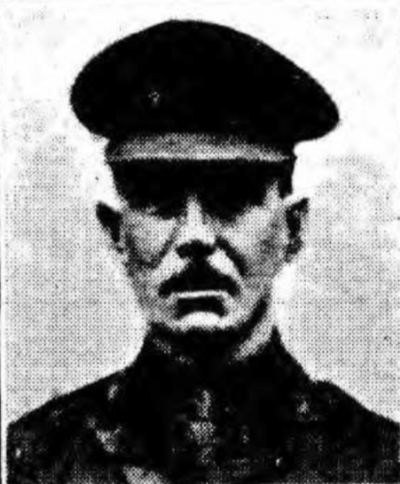
Students at Hackforth and Hornby School researched this story for the Ribbon of Remembrance.
Do you know the story of Major Robert Henry Edmund Hutton-Squire? He was a World War 1 Hero. A person from our area: a soldier in the British Army who fought for our freedom.
Major Robert Hutton-Squire was born on the 10th October 1877, at Holtby Hall, his family home, in the Parish of Hornby, near Bedale.
As a child, Robert grew up at Holtby Hall with his older siblings, John and Emmeline; his younger siblings, Lucy and Eleanor; his father, Robert, a magistrate and militia army officer and Catherine, his mother. Very sadly, Lucy died in 1903, before the outbreak of World War 1. She was buried at St Andrews Church in Great Fencote, near Holtby Hall.
The family were looked after by their servants, including a housekeeper, a butler, a cook, a nursery maid and a gardener.
Robert Hutton-Squire did not go to his local school (Hackforth & Hornby C of E Primary School). In 1891, he was a boarding scholar at Charterhouse School with his brother, John. He was at school, away from his family.
After he left school, Robert trained as an engineer. In 1899, he was working in India, in Madras. In 1900, he joined the British Army in India, as an officer in the Royal Artillery. He was promoted to Lieutenant in 1901. In 1906, his father died and was buried alongside his daughter in Great Fencote.
In 1911, Lieutenant Hutton-Squire returned to England, to Shoebury Barracks. This is recorded in the 1911 Census. A year later, he was promoted to Captain. On 14th July 1914, aged 39, he married Violet Hamilton in Edinburgh.
Robert Hutton-Squire fought in France and Belgium from September 1914. He was promoted to Major in 1915 and took part in the Battle of the Somme in 1916. In January 1917, Major Hutton-Squire was awarded the Distinguished Service Order (DSO). Tragically, he was wounded near Arras and died in hospital in April 1917; five months later, on 29th September, his son, John was born. Major Hutton-Squire was buried in the Barlin Hospital Cemetery, in France. His friends remembered him as a good, kind, brave soldier.
As Robert Henry Edmund Hutton-Squire is remembered on the Memorial Plaque in St Mary’s Church, Hornby, the junior pupils at Hackforth and Hornby C of E School researched his life; created time lines and wrote a biography together, to celebrate his life. The pupils used census returns from 1881 to 1911; War Memorial Records from Charterhouse School; the Roll of Honour and maps to investigate his life. All the junior pupils hope you enjoyed reading their biography.

Explore more memories from the ribbon
-
Joseph Snowden Atkinson
Submitted by Mavis Marwood a resident of Richmond for the last 10 years. Private Joseph Snowden Atkinson (204103) was my grandfather. He was born in Gainford and lived in Ravensworth. Like his father his occupation was as a stonemason. He served in France during the war and was one of the lucky soldiers to survive the conflict. One of the images is a handmade Christmas card that he sent from the front line to my mother when she was little girl. On his return to Ravensworth he went on to become a master stonemason.
-
Ernest Brooke
Sgt. Ernest Brooke was born in Brighthouse, Yorkshire in 1886. In civilian life Ernest worked a railway signalman. Ernest’s medal records show he was entitled to the 1914 Star indicating that he was an ‘Old Contemptible’, part of the original British Expeditionary Force that fought in France and Belgium from August 1914. Ernest served with the 2nd Battalion of the Yorkshire Regiment until his death on 4th January 1918. The New Year 1918 that at 11pm (German midnight) on the 31st December 1917, ‘…all guns of artillery fired one round each, whilst machine guns fired two belts of ammunition each ‘to usher in the new year’. The following day, the 2nd Battalion were relieved from the front line and relocated to ‘Hedge Street Tunnels’. On the night of the 4th of January, a fire broke out in the area of the tunnel being occupied by the Battalion, resulting the loss of a further 20 lives from the 2nd Battalion – one of those lives being Ernest Brookes’. In accordance with his wishes, Ernest’s outstanding pay and War Gratuity, totalling £29, 7shillings and 19d to his mother, Hannah.
-
William Hird
William Hird was nominated for the Ribbon of Remembrance by Dianne Evans, and his story illustrates a problem that can occur with records that are a century old. Thanks to the original 1914-16 enlistment leger at the Green Howards Museum, we can say with some confidence that William enlisted on 10th December 1914 in the City of Durham and that he was posted to the 3rd Battalion, based at West Hartlepool on 18th January 1915. According to his medal card 18390 Acting Lance Corporal William Hird served in France from 19th September 1915, and was entitled to the 1915 Star, the British War Medal and the Victory Medal. William is recorded on the ‘Soldiers died in the Great War 1914-1919’ database as having died on 29 September 1916 as a Private in the 7th Battalion of the Yorkshire Regiment. This might have been the case, but on examining the battalion war diary, the 7th Battalion were away from the frontline in training and there are no records of any deaths that day. Of course soliders would often die from wounds days after an offensive, however the Green Howards Gazzette for December 1916 records that 18390 W Hird was Killed in Action – there is a separate list for those who Died of Wounds. On further investigation, the Register of Soldier’s Effects lists William as being in the 6th Battalion when he was killed in action in France. The war diary of 6th battalion recounts the attempted assault on ‘Stuff Redoubt’…
